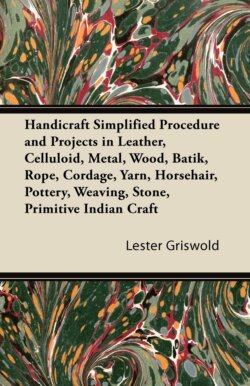Читать книгу Handicraft Simplified Procedure and Projects in Leather, Celluloid, Metal, Wood, Batik, Rope, Cordage, Yarn, Horsehair, Pottery, Weaving, Stone, Primitive Indian Craft - Lester Griswold - Страница 7
На сайте Литреса книга снята с продажи.
INTRODUCTION
ОглавлениеWe must turn from the machine made products of modern life to contrast the lasting value and charm of almost anything made by hand. Something is contributed by the personality of the maker, expressed by the skill and effort with which he worked, that enhances the value of anything to the extent that it is hand wrought. We almost instinctively realize this value and our appreciation is part of the heritage of the past.
The beginnings of craftwork go back beyond the traditions which preceded history, back to prehistoric man, from whose relics we know, that one of the first steps toward civilization was taken when he learned to fashion crude weapons and implements which he soon began to decorate with a surprising degree of artistic skill. The earliest material seems to have been stone, then bone and ivory which were first engraved then later inlaid with metals and combined with wood in the making of handles, which were attached or “hafted” with thongs to knives or axes of flint.
Metal came into use in the Iron and Bronze Ages and articles for decoration as well as for utility were constructed. Gold was soon after introduced and the art of making colored enamels was developed. By this time man had learned to make furniture for his dwellings, altars and images for his temples, increasing his skill and improving his workmanship through the centuries until we find the first written accounts of his craftwork in the records of ancient Egypt, in Greek literature, and in the Bible. Through the Dark Ages some of the attainments of the ancient crafstmen were lost, but many others were fortunately preserved in the abbeys and monasteries where later they were brought to a high degree of perfection, as in metal working wood carving, tapestry weaving and the embossing of leather bindings for hand written vellum manuscripts.
With the revival of civilization in the Middle Ages, the cherished knowledge and skill of the monks was restored to the people and the development of crafts through this period is closely linked with the history of the Guilds. A thoroughly fascinating and authentic picture of the medieval craftsman is presented by Katherine Gibson in a library volume “The Goldsmith of Florence” which is termed “A Book of Great Craftsmen.” It will charm and inspire the modern craftworker and should be read by all who would catch the spirit of this great age of Arts and Crafts.
In this country we have a twofold heritage of attainment in Arts and Crafts, that of the early American colonist who brought from Europe the best of the culture of his native land, and that of the first American, the Indian, whose decorative arts were developed centuries before the coming of Columbus. His contribution to American culture is only now being recognized and appreciated and noteworthy efforts are being made to restore and preserve for both the Indian and the white man his music, his tribal pageantry and especially his decorative arts, which are largely the symbolic expression of Indian history, philosophy and religion. A sympathetic study of these two contrasting streams of culture should encourage and inspire us to adapt in our own work as much as possible of the unique beauty and charm of both the Colonial and Indian arts and crafts.
